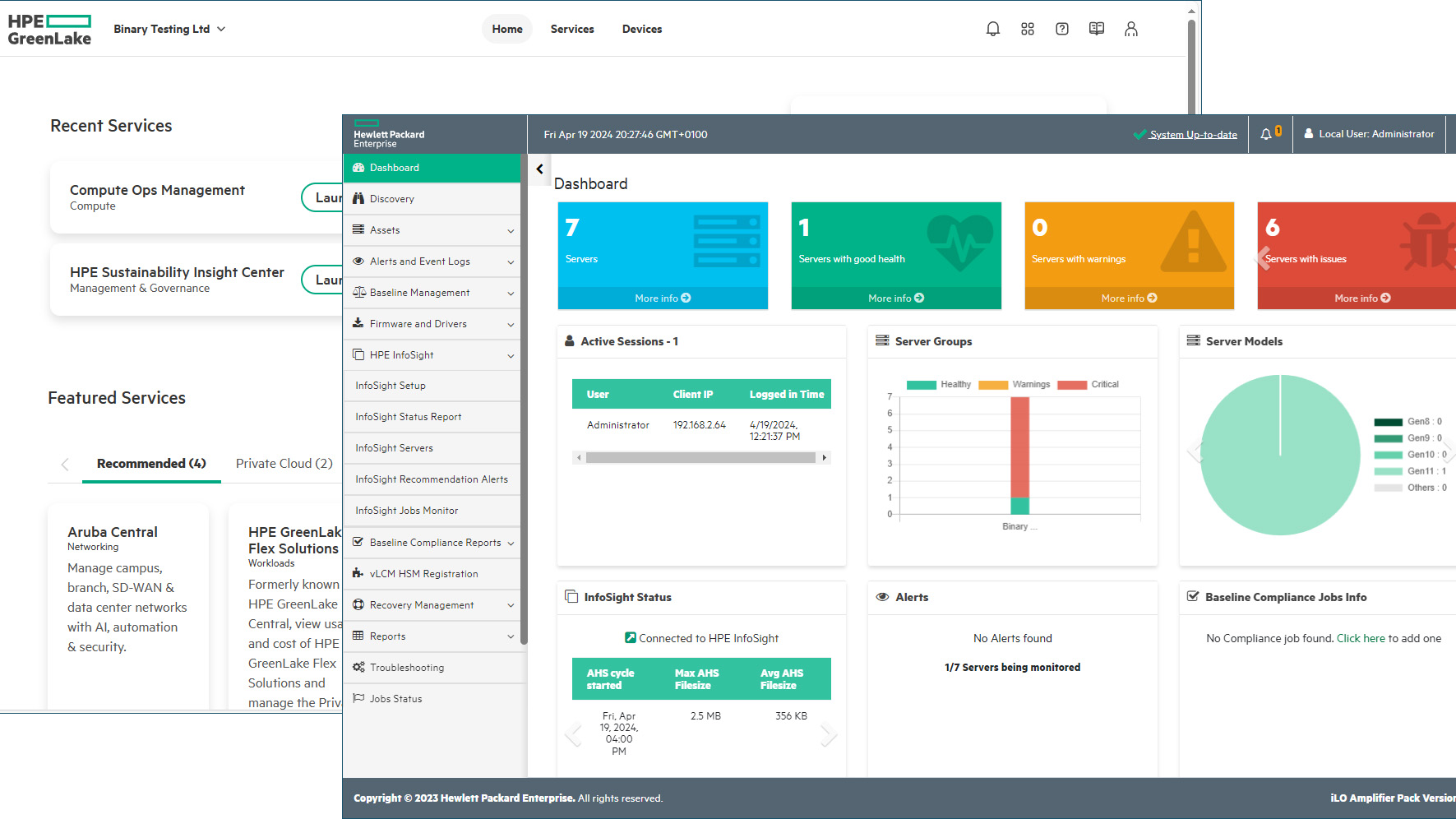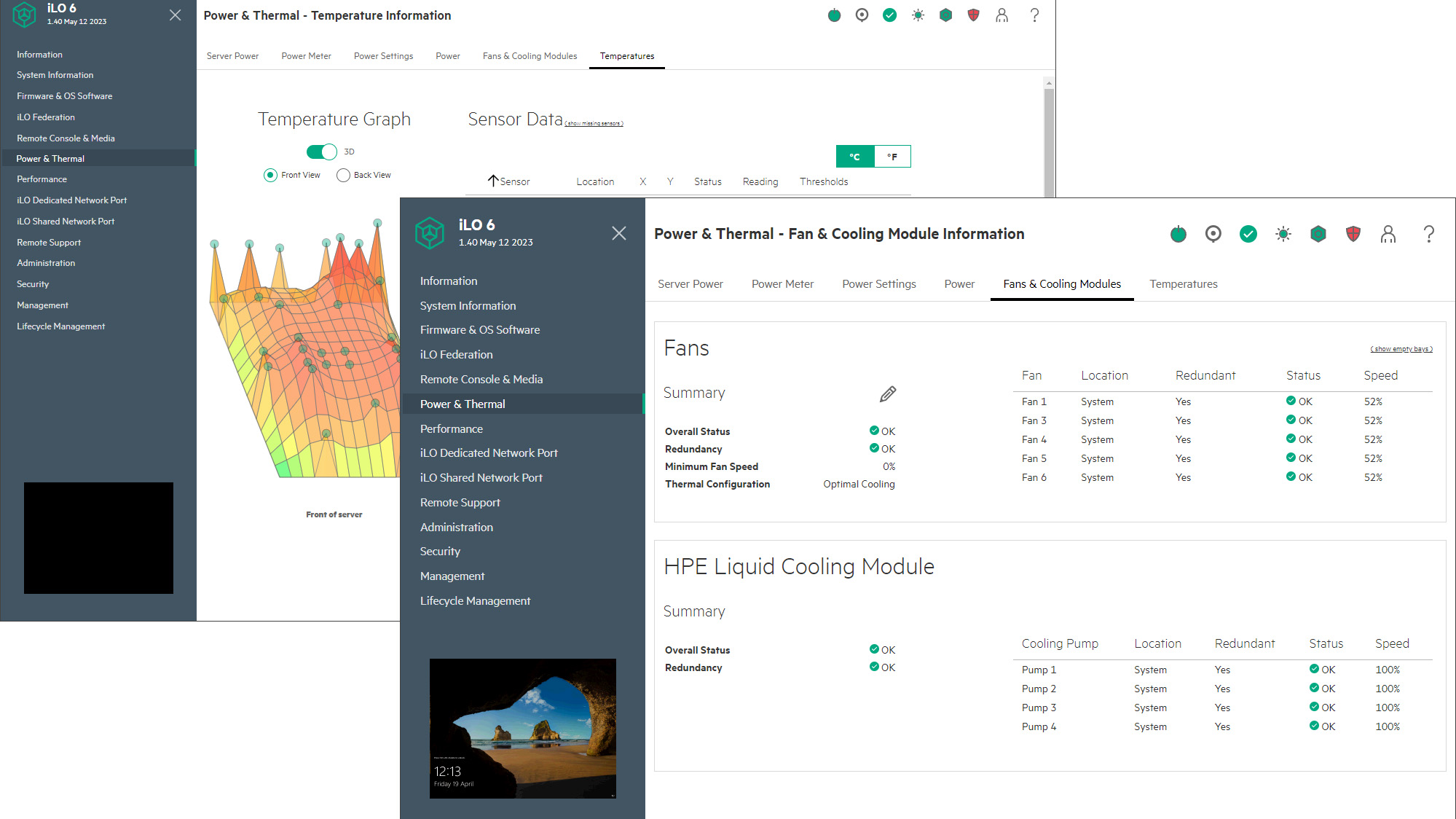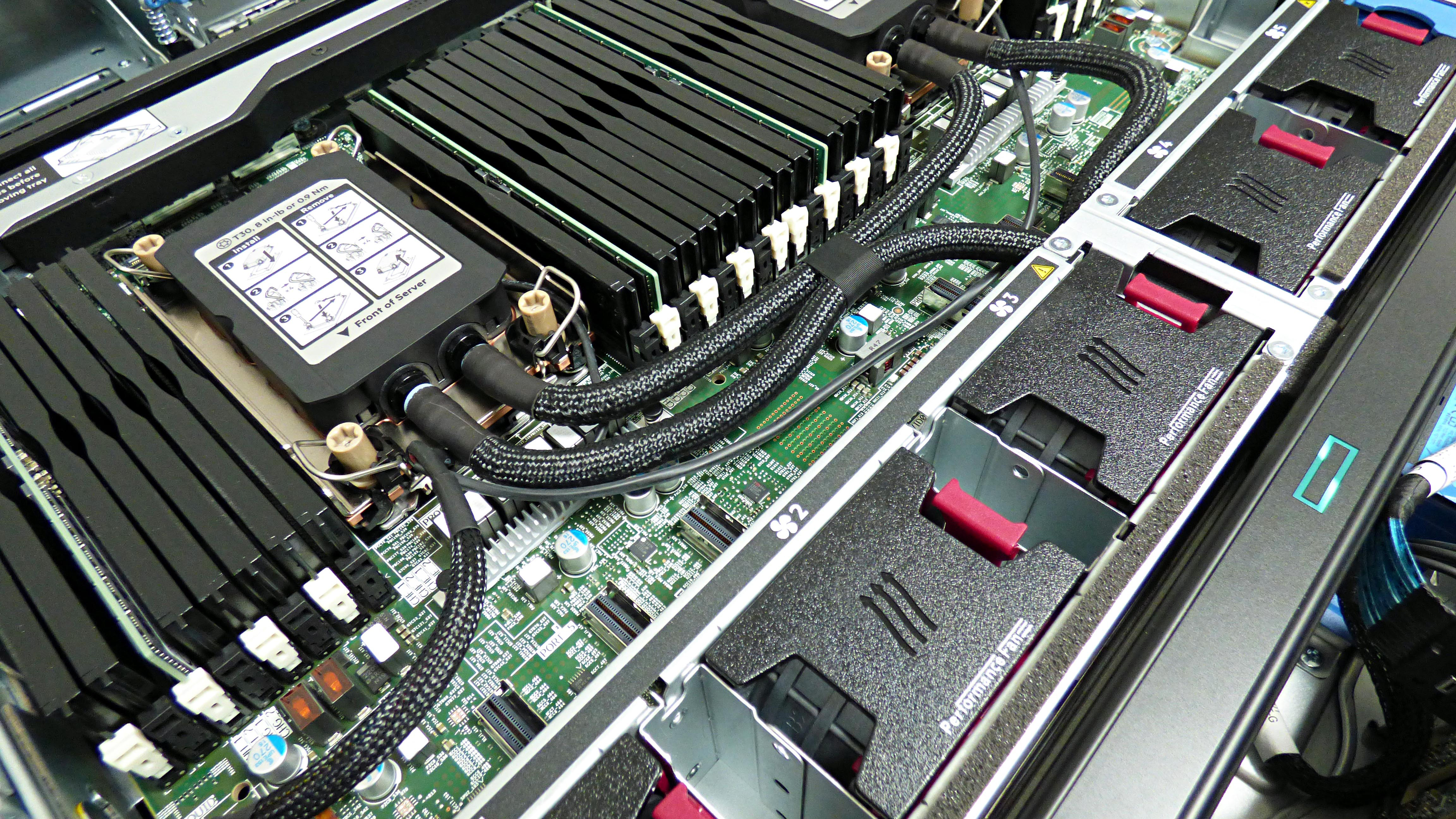HPE ProLiant DL560 Gen11 review: A smart liquid-cooled rack server for budget-conscious enterprises
The DL560 has a unique closed-loop liquid cooling system capable of handling a diverse range of heavy-duty workloads

-
+
Classy design
-
+
Smart liquid cooling
-
+
Supports all Xeon Scalable Platinum CPUs
-
+
High memory capacity and expansion potential
-
+
Great remote management features
-
-
No coolant leak detection system

Enterprises baulking at the high costs of implementing liquid cooling in their data center racks will find HPE has a very interesting and more affordable alternative. The ProLiant DL560 Gen11 keeps it all inside the box with an innovative closed-loop liquid cooling system.
No need for costly rack conversions as this 2U rack server is a completely self-contained system. It employs cold plates with integral pumps for each CPU and routes the coolant through to a full-width radiator in front of a bank of cooling fans.
The DL560 Gen11 has more tricks up its sleeve as this is a quad-socket (4P) server and supports all Gen4 Xeon Scalable Platinum CPU models up to the 60-core 8490H and its big 350W TDP. It also has 64 DIMM slots allowing it to present a massive 16TB of fast DDR5 memory.
HPE ProLiant DL560 Gen11 review: Liquid cooling design
The server is extremely well built but what lies beneath the lid is of more interest. Squeezing quad Platinum CPUs and 64 DIMMs into a 2U chassis is no mean feat and HPE has achieved this with a mezzanine card.
You can order a base 2P system where the main motherboard sits in the chassis base and has two CPU sockets and 32 DIMM slots. The 4P model on review has the removable mezzanine card sitting on top which provides the other two CPU sockets and remaining DIMM slots. For CPUs with 270W-350W TDPs, liquid cooling is the only option and the kit must be ordered as a factory installation.

The upper and lower boards effectively have separate liquid cooling circulations as each CPU pair has their cold plates linked together by one inner pipe with another on each outer side routed through to the radiator. It all makes for a tidy arrangement as each board only has three pipes with the pump in each cold plate powered by cables routed from a single board connector.
There's no special sauce as the coolant is a mixture of purified water, ethylene, and corrosion-resistant additives. Leak detection systems are not available but the pumps provide redundancy as if one fails, the corresponding one will continue to circulate the coolant albeit at the risk of increased operating temperatures.
Sign up today and you will receive a free copy of our Future Focus 2025 report - the leading guidance on AI, cybersecurity and other IT challenges as per 700+ senior executives
The server comes with a standard three-year warranty but you may want to consider HPE's 5-year extension. The cooling system has a maximum usage limitation of five years and after this period has elapsed it must be replaced by HPE at the customer's expense.
HPE ProLiant DL560 Gen11 review: Management and monitoring
HPE's iLO6 controller presents a dedicated network port and a smart web interface packed with valuable monitoring features. It provides a wealth of information about server operations while platform security is assured with features such as the iLO6 Secure Start, 'silicon root of trust' firmware fingerprinting, and global component authentication.
The Power & Thermal page shows details of the fans and the liquid cooling module. For the latter, it lists the status of each pump, redundancy conditions plus speed, and if the iLO6 detects any problems it can issue SNMP traps and email alerts.
There's plenty more in HPE's management portfolio as the on-premises OneView app links up with the server's iLO6 and provides a central web console for monitoring and managing all HPE systems, hypervisors, storage arrays, pools, and switches. We also run HPE's iLO Amplifier Pack in the lab as a Hyper-V VM which provides discovery, inventory, and compliance reporting for up to 10,000 Gen8, 9, 10, and 11 servers.

Next up is HPE's GreenLake cloud platform with its Compute Ops Management (COM) service providing complete lifecycle management of HPE servers. ProLiant Gen10 and Gen11 servers connect directly to the COM cloud portal with earlier iLO versions linking to it via OneView – you'll find our in-depth review of COM here at IT Pro.
HPE ProLiant DL560 Gen11 review: Storage and expandability
Along with great processing power, the DL560 Gen11 puts plenty of storage options on the table. It employs HPE's standard triple front drive cage arrangement and can support a maximum of 24 SFF SATA, SAS, and NVMe devices or up to 24 EDSFF E3.S SSDs.
Our system comes with the central 8-bay drive box plus a quartet of 1.6TB NVMe SSDs and you can upgrade capacity by adding a second and third cage as required. The EDSFF boxes each support twelve E3.S SSDs with a maximum of two but you could use the third bay to the left for HPE's universal media cage.
Basic SATA/NVMe RAID is managed by Intel's embedded VROC (virtual RAID on CPU) controller but NVMe support is disabled by default and requires an extra enablement key. A VROC Standard key adds NVMe support and RAID10 while a Premium key brings RAID5 into play.
This wasn't an issue for us as our review system came with HPE's tri-mode MR416i-p Gen11 PCIe card. Along with support for RAID5 and 6 arrays, its 8GB of cache memory is protected by a battery pack mounted in front of the coolant radiator.

Expansion potential is impressive as the server has room for two risers each with three Gen5 PCIe slots and graphics acceleration is covered as it can handle six single-width (SW) or two double-width (DP) GPUs. Lurking beneath the risers are two OCP 3 PCIe 5 slots which support HPE's 'o' RAID cards and plenty of network card options with one of our slots occupied by an Intel dual-port 100GbE adapter.
HPE ProLiant DL560 Gen11 review: Is it worth it?
It is if you want the highest CPU core density and memory capacity in the smallest of rack spaces. The ProLiant DL560 Gen11 has many other benefits as even with core-heavy Xeon Scalable Platinum CPUs in play, storage capacity is undiminished and it offers a high expansion potential with support for up to six GPUs.
HPE's unique closed-loop liquid cooling system allows the server to deliver a hardware package that's clearly capable of handling a diverse range of heavy-duty workloads. It isn't limited to this server either, as it's also available for the DL325 Gen11 and DL360 Gen11.
HPE ProLiant DL560 Gen11 specifications
| Chassis | 2U rack |
| CPU | 4 x 16-core 2.9GHz Xeon Scalable Platinum 8444H |
| Memory | 512GB DDR5 HPE SmartMemory (max 16TB) |
| Cooling | Closed-loop liquid cooling, 5 x high-performance hot-plug fans |
| Storage bays | 8 x hot-swap SATA/SAS3/NVMe SFF (max 24) |
| RAID | HPE MR416i-p Gen11 PCIe/8GB/BBU |
| Storage included | 4 x 1.6TB U.3 NVMe SSDs |
| Network | Intel dual-port 100GbE QFP28 OCP3 |
| Expansion | 3 x PCIe Gen 5 (max 6), 2 x OCP 3 Gen5 |
| Power | 2 x 1600W Platinum hot-plug PSUs (max 4) |
| Management | HPE iLO6, OneView, iLO Amplifier, GreenLake COM |
| STD Warranty | 3yrs parts, labour, on-site support (4 and 5yr extensions available) |
Dave is an IT consultant and freelance journalist specialising in hands-on reviews of computer networking products covering all market sectors from small businesses to enterprises. Founder of Binary Testing Ltd – the UK’s premier independent network testing laboratory - Dave has over 45 years of experience in the IT industry.
Dave has produced many thousands of in-depth business networking product reviews from his lab which have been reproduced globally. Writing for ITPro and its sister title, PC Pro, he covers all areas of business IT infrastructure, including servers, storage, network security, data protection, cloud, infrastructure and services.
-
 A concerning number of Log4j downloads are still vulnerable four years on
A concerning number of Log4j downloads are still vulnerable four years onNews Despite safe Log4j versions having been available for years, many organizations haven't introduced them
By Emma Woollacott Published
-
 Gender diversity improvements could be the key to tackling the UK's AI skills shortage
Gender diversity improvements could be the key to tackling the UK's AI skills shortageNews Encouraging more women to pursue tech careers could plug huge gaps in the AI workforce
By Ross Kelly Published
-
 Researchers claim Salt Typhoon masterminds learned their trade at Cisco Network Academy
Researchers claim Salt Typhoon masterminds learned their trade at Cisco Network AcademyNews The Salt Typhoon hacker group has targeted telecoms operators and US National Guard networks in recent years
By Emma Woollacott Published
